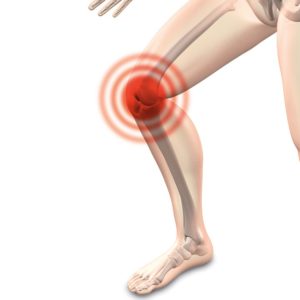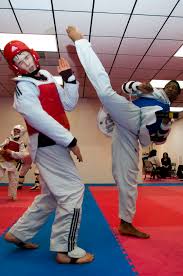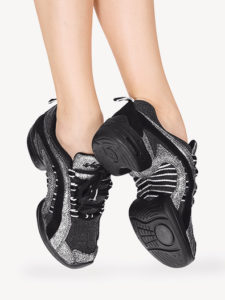
People from many walks of life deal with knee pain and swelling. Whether its occasional or every day. It can hamper your activity level and even make you down right miserable. There are many causes for knee pain and swelling, a couple of those being injury and overuse.

An injury may have occurred while participating in a sport or athletic activity, landing badly after jumping from even the smallest elevation, tripping and falling, or in a car accident.
Overuse can come from working a job that requires you to stand on your feet for many hours a day and other activities that may require you to kneel or carry a heavy load, over and over again. Participating in a strenuous sport over many years, such as martial arts, running, dancing, weight lifting can wear the joints down.

Overuse can also come in the form of being overweight. Walking and pounding the joints with extra weight on the frame can cause early degeneration in the knees and other joints.
Wearing non-supportive shoes especially when engaging in physical activity can also be a contributing factor to knee pain and swelling.
The Importance of Wearing Sport Specific Shoes
Something that I found to be of the utmost importance as a dancer and athlete was to wear the right shoes for what I was doing. Also important is to make sure shoes are replaced when they begin to wear as it puts undue stress on the body’s whole frame.

When I was teaching dance fitness classes, I could tell when my dance sneakers were beginning to wear because I could feel it in my knees. My legs would tire much faster. I also found that if I wore shoes other than dance sneakers when I was teaching my dance fitness classes (shoes that stuck to the floor), it would cause a lot of pain and discomfort not only in my knees and legs but also in my hips and low back. Improper shoes forced me to recruit other muscles in excess in order to perform the same movements. Shoes that might otherwise be great for boot camp, running or weight training are too sticky on the floor for dance. Dancing movements often involve twisting and sliding on the floor, as an example.
Cycling shoes are a much better choice when riding a bike or when participating in a spin class. The sole is stiffer, there by taking pressure off of the sole of the foot and making each pedal stroke more efficient.

Same goes for running shoes. Depending on the type of running event an athlete participates in, determines which running shoe works best for his or her particular sport. For the recreational runner, good supportive running shoes that fit properly and distribute the forces most effectively into the foot and ultimately the body are very important to help prevent impact and injury to the knees and other joints.
How to Treat a Swollen Knee – The RICE principal
Rest, Ice, Compression, Elevation. When an injury or a flare up of pain occurs, it’s important to rest from strenuous or prolonged activity to encourage the area to heal. However, lack of movement isn’t good either. It’s important to talk with your doctor or physical therapist about exercises that will help to heal the painful, swollen knee. Immobility may be necessary for a little while but also incorporating some exercises to maintain the strength of the muscles surrounding the knee are important in the healing process.
ICE IS YOUR FRIEND! Ice is very helpful in decreasing pain and inflammation. The sooner that you apply ice to the injured knee, the better. Inflammation is a normal process early on after an injury that can help in healing the injured area and can keep the injured person from using it, protecting it from further injury. The body’s response, however is often excessive. Too much inflammation that can have adverse effects. Icing soon after the injury or swelling occurs and as often as possible (up to 20 minutes per hour), for the first 48-72 hours will help to minimize swelling and decrease pain. Elevating while icing is even better.
If knee pain is a regular thing for you, I also recommend icing after activity or prolonged standing.
Compression is helpful early on in an injury to help with swelling. It gives the knee support when you’re up and about. Compression can be painful for some people for prolonged periods, so be mindful and take breaks from compression. Make sure to remove the compression bandage or sleeve for sleep.
Elevating the knee above the heart (or at least at the level of the heart) helps drain fluid away from the area. Ice while elevating for a more optimal affect.
Methods of Icing I’ve found to be most effective
1) Ice massage for the knee is my all time favorite as I find it to be most effective and takes less time.
- Get a box of 5 oz. Dixie cups
- Fill a few up with water (to about 1/4 inch from the rim)
- Freeze
- Peal paper cup from around the ice leaving a bit of cup to still hold onto
- Massage the ice around the knee for 8-10 minutes
*As the ice melts, it’s going to run down to the surface your leg is resting on so I suggest a towel under your leg to catch the water.

2) Colpac ice pack. My very favorite Ice pack. I use it on my patients in my chiropractic practice and I have two extra large ones in my freezer at home. They are the best because they are very durable for many icing sessions and they are a soft pliable pack that can be molded around the body part you’re icing. They retain the cold for 30 minutes (however I would not ice for more than 20 minutes at a time). The pack is real cold so you want to make sure you place a bandanna, or a thin kitchen towel between the pack and your skin. You don’t want the towel to be too thick that you don’t get the knee cold enough. Ice for 15 to 20 minutes maximum.
Check out my upcoming review on the Colpac ice pack.
3) In a pinch, if you don’t have an ice pack or have your Dixie cups ready, you can always use a bag of peas, or a bag of ice. I find that the bag of peas aren’t quite cold enough. Again use for 15 to 20 minutes maximum
Anti-inflammatories
Your doctor may recommend over the counter anti-inflammatory meds such as Ibuprofen or Naproxen. If you prefer or need to stay away from medications, I can recommend more natural methods of decreasing inflammation.
Our body’s chemistry is extremely important in order for it to heal optimally. Foods that we eat can affect our body positively or adversely when it comes to performance and healing.
Also, there are various supplements that are helpful for pain and inflammation. Check out some of my other posts that you might find helpful.
- Dandelion Tea helps decrease inflammation and swelling
- Benefits Turmeric Curcumin -Alternative pain relief
- Best Foods to Eat for Inflammation – You should eat these every day
I hope this has helped inform you on how to treat a swollen knee.
Conclusion
Due to my life style, I over used my knees for 50 years. I had a lot of fun over the years destroying my knees and now I’m having to deal with the after effects.
I have found, in order to minimize the pain in my knees, it takes living a very conscientious life. Focus on healthy everything: Healthy food, supplements, exercise, rest, thoughts and spirituality.
Let me know if you have any questions about this and feel free to share with me your experience with knee injuries and helpful therapies.
In Good Health,
DrDina



Hi Dina,
Thanks so much for writing this post on how to treat swollen knees. I really enjoyed reading it and learned a lot. I never thought that wearing the right shoewear was that important. I always thought that as long as you wear some kind of sportshoes, it wouldn’t matter. But you definitely convinced me otherwise.
Keep up the great work!
Hi Ios,
Thanks for visiting my site. I’m glad that you enjoyed my post and that it was informative for you. Let me know if you notice a difference when you incorporate sport specific shoes to your activities.
Have a great one,
DrDina:)